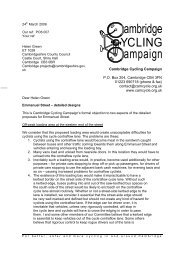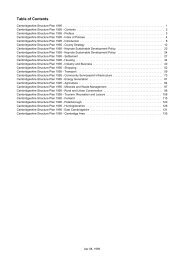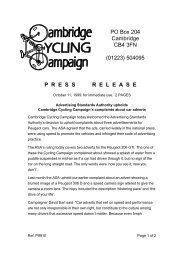Printable PDF version - Cambridge Cycling Campaign
Printable PDF version - Cambridge Cycling Campaign
Printable PDF version - Cambridge Cycling Campaign
- No tags were found...
Create successful ePaper yourself
Turn your PDF publications into a flip-book with our unique Google optimized e-Paper software.
and the problems it causesC2020JunctionsWe also believe that the double roundabout atthe Royal <strong>Cambridge</strong> Hotel, one of the mostdangerous and accident-prone junctions in the city,could be improved by the re-introduction of traffic lights.Modern traffic light systems can avoid the queuingexperienced in previous decades.Some traffic lights could also be reworked to benefitboth cyclists and pedestrians. The Downing Street/StAndrew’s Street junction is a classic case where thecontinental style “left on red” system could be tried.This is where cyclists may turn left if no pedestrians arecrossing, and works very well abroad.An example of a well thought out and useful left turn isthe junction at the end of Hills Road bridge and CherryHinton Road, where the separate left turn lane for cyclistsenables them to bypass the traffic lights completely.Addressing niggles on a city-wide basisWhile a few large-scale projects are requiredto make cycling safer and more convenient in<strong>Cambridge</strong> there are also many small things that can bedone to make a big difference.Every cyclist in the area can name numerous small,niggling problems along their regular cycle routes and inmany cases putting these right should be an inexpensiveprocess. These include bumps, potholes, dropped kerbswhich are not flush with the road, or any of the othernumerous small obstacles which are the legacy ofdecades of bad design. There needs to be a concertedand systematic effort to identify all these minor problemsand remove them from the city’s streets.“A systematic effort to get rid of thenumerous little niggling problems thatevery cyclist faces on their daily journeywould make journeys so much morepleasantFor the future, if high-quality cycle provision is installed inthe first instance, and well maintained, such niggles willbe vastly reduced.“ConclusionAll the above are just some of the many examplesof badly designed infrastructure across the city,provision which actually provides very little benefit toanyone. Such facilities mean that transport authoritiescan be seen to be fulfilling their duties whilst supplyingsomething that is actually of negligible value and doesnothing to encourage cycle use, and can in fact makecyclists feel less welcome on the road.Determined efforts need to be made to tackle this legacyso that the entire network is open, accessible and safefor cycling. Routes need to be identified and redesignedwith high-quality materials and a genuine political willto create more space on the roads for cycling. There isalso need for better guidelines to help planners assesswhether a path is suitable for shared use, segregatedshared use or whether on-road provision is a betteroption.“Tackling the legacy of badprovision by 2020 is essentialto make cycling easier, moreaccessible and safe for everyone“CYCLING2020SECTIONTHREE.. BadinfrastructureSECTIONTHREE.. page9







